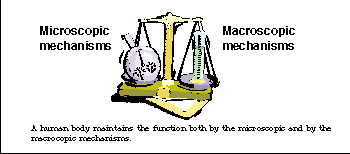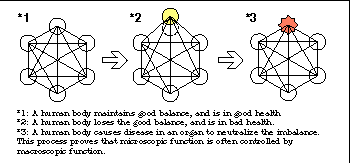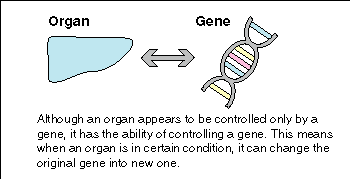 |
 |
|
|
|
 |
I. Human Body 4/4
We should understand that not only the microscopic but also the macroscopic mechanisms play a major role in disease. |
|
|
|
|
|
|
4. Relationship between
Macroscopic and Microscopic Mechanism |
|
Although a human body appears to maintain the function only by using the microscopic mechanisms, it maintains the function on the basis of the relationship between the microscopic and the macroscopic mechanisms. In general, the majority of medical researchers tend to think that a human body maintains the function only by using the microscopic mechanisms such as chemical reactions and genetic functions. Just this thought must prevent medical researchers from finding out the fundamental cause of disease. That is, medical researchers should notice the fact: a human body maintains the function both by using the microscopic and by the macroscopic mechanisms.
|
|
|
|
 |
|
(A human body maintains the function both by the microscopic and by the macroscopic mechanisms.) |
|
|
|
|
|
|
Interestingly enough, a human body often changes the microscopic functions by the requirement of the macroscopic functions. A human body, as explained in the previous section, maintains the life by the stability, which originates in the balance among the organs. This means that a human body obtains the stability on the basis of the macroscopic function. Thus, when a human body loses the good balance among the organs, it aggressively regains the balance by changing the microscopic functions such as metabolism in an organ. As seen in this example, the microscopic function not only controls the macroscopic function, but also is controlled by the macroscopic function. |
|
|
|
 |
|
(*1: A human body maintains good stability, and is in good health. *2: A human body loses the good balance, and is in bad health. *3: A human body causes disease in an organ to neutralize the imbalance. This process proves that microscopic function is often controlled by macroscopic function.) |
|
|
|
|
|
|
• An Organ and A Gene
All in all, the indications above allow us to conclude as follows: there is a strong possibility that an organ in a certain condition aggressively changes the original genes into other genes such as oncogenes. In general, the majority of medical researchers think that a gene is a blueprint of a human body, and has the ability to completely control all the metabolism in a human body. Certainly, this thought is correct in a sense. However, medical researchers need to know the fact: whereas a gene can control an organ, it is also controlled by an organ. A human body evolves itself by adapting the circumstance: in this process, it is not a gene but an organ to firstly sense the change in circumstance; that is, an organ changes the genes in order to adapt the circumstance. These reasons enable us to conclude that an organ has the ability to control the genes. This means that even if medical doctors try to control disease by using gene therapy, they will be unable to completely control disease including cancer. |
|
|
|

|
|
|
|
|
|
|
MyBook

PDF File Download

(Donation Ware)
SugiInternalMedicineClinic
MIKIOSUGI: 杉幹雄
Present Japan Time:
2025/07/31 (Thu) 15:57:07 |
|